We’re No. 1! is a weekly feature looking at first issues in new comic series, as well as one-offs and special releases. In his reviews, Jeff highlights stories with diverse characters and plot lines Geekquality readers can care about, as well as points out comics that miss the mark.
Weekly Recap
In recent weeks, it’s been clear that diversity in new comic book series has been headed in a very specific direction. While publishers from the Big Two to the smallest indies have been cranking out comics starring the “Strong Female Character” (a term that can be infinitely defined and debated), people of color have been consistently absent from major starring roles. That course took a big correction this week with three new titles featuring Black men center stage, some subtly tackling issues in the Black community, others smashing into them head on.
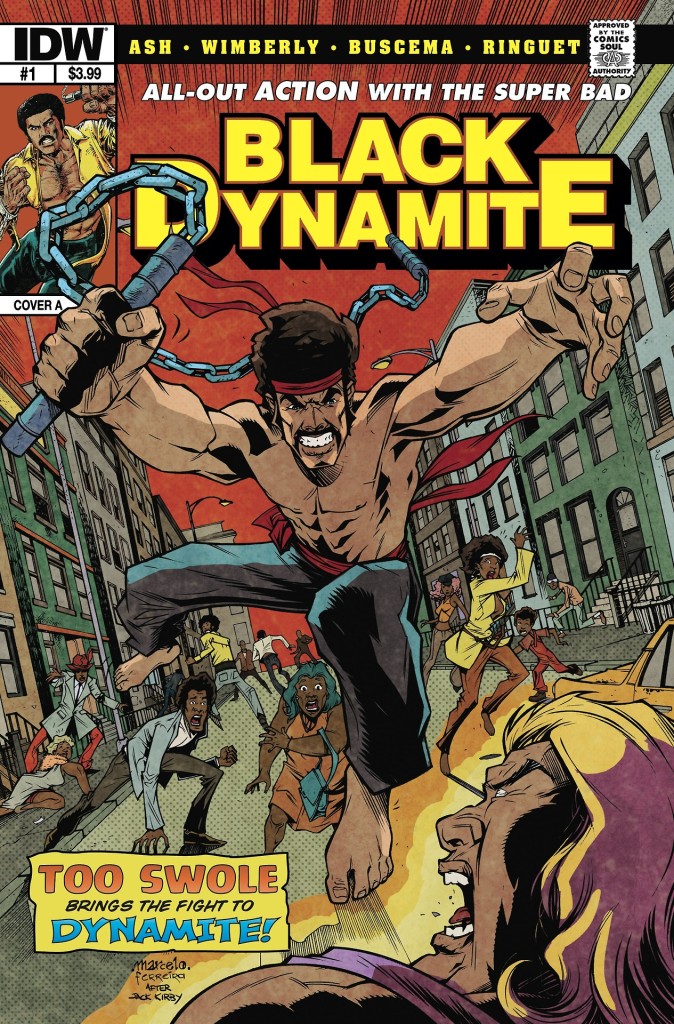 Diving into things head first is Blaxploitation parody hero of Black Dynamite #1, written by Brian Ash with pencils by Ron Wimberly. Based on the character from the film by Michael Jai White, Black Dynamite is a former CIA agent turned street vigilante, determined to clean up his 70’s era neighborhood of drugs and gangs. But when he faces off against the villain Too Swole, Black Dynamite is forced to face a harsh reality by none other than Roots author Alex Halley. Black Dynamite himself is harming the community by using violence to solve its problems. The glorification of violence perpetrated by young men in their own community is a harsh pill for Black Dynamite to swallow, and he decides to leave his ‘hood behind when Halley makes him realize that the Black community “simply can’t endure being your personal battlefield.” Though a touch misogynistic (Black Dyamite doesn’t leave until her gets assurances from his girlfriend that she loves him and will wait for him to return, but it’s okay for him to sleep with other women while he’s away), the story is a fairly humorous take on the general concept that super heroes solve problems by physically destroying neighborhoods in their pitched battles. (One can only image the citizens of Metropolis, especially the architects among them, felt the same way at the end of Zach Snyder’s Man of Steel.) Ultimately, the book shines the same level of parody and humor on the Blaxploitation genre that the well-received film did before it.
Diving into things head first is Blaxploitation parody hero of Black Dynamite #1, written by Brian Ash with pencils by Ron Wimberly. Based on the character from the film by Michael Jai White, Black Dynamite is a former CIA agent turned street vigilante, determined to clean up his 70’s era neighborhood of drugs and gangs. But when he faces off against the villain Too Swole, Black Dynamite is forced to face a harsh reality by none other than Roots author Alex Halley. Black Dynamite himself is harming the community by using violence to solve its problems. The glorification of violence perpetrated by young men in their own community is a harsh pill for Black Dynamite to swallow, and he decides to leave his ‘hood behind when Halley makes him realize that the Black community “simply can’t endure being your personal battlefield.” Though a touch misogynistic (Black Dyamite doesn’t leave until her gets assurances from his girlfriend that she loves him and will wait for him to return, but it’s okay for him to sleep with other women while he’s away), the story is a fairly humorous take on the general concept that super heroes solve problems by physically destroying neighborhoods in their pitched battles. (One can only image the citizens of Metropolis, especially the architects among them, felt the same way at the end of Zach Snyder’s Man of Steel.) Ultimately, the book shines the same level of parody and humor on the Blaxploitation genre that the well-received film did before it.
 Dark Horse Comics has their own hero of color in Skyman #1, written by Joshua Hale Fialkov with art by Manuel Garcia. Skyman is a hero sanctioned by the US Government, a soldier given an advanced helmet and belt that allows him to fly and gives him superior strength and reflexes. But when the previous Skyman gets into an altercation with the hero Captain Midnight, he’s released from service, taking his superpowers with him. The downward spiral of this man leads to a violent and racist public outbreak. This creates a PR scandal for the government and the sitting President, an obvious allegory of Barack Obama, whom the fallen hero brazenly describes with negative racial epithets on live television. Thus the search for a new Skyman is on and the man in charge, General Abernathy, is determined to choose a Black man for the role, finally ending up with Sargent Eric Reid, a wounded Marine who has lost the use of his legs in combat. Reid is well aware that he’s being used partially as a PR stunt, but the Skyman technology allows him to walk again, not to mention fly, and he’s a soldier ready to do his duty for his country. However, his sadistic field leader Lieutenant Sharp knows that Reid’s reliance on the Skyman tech means Sharp can keep Reid under his thumb. He reminds the new Skyman of this rather forcefully at his press debut with the President by turning off the tech in mid flight, reducing Reid to a falling rock, only to revive the tech at the last moment. The message of white men manipulating the system to their own advantage is all too obvious. The nod to Affirmative Action, quite a bit on the nose, is slightly more complicated. It’s great to see characters of color front and center, especially in entertainment genres where they are drastically underrepresented. However, Skyman is an obscure hero and a far stretch from Miles Morales becoming Spider-Man. We don’t know Eric Reid the way readers know Miles or Luke Cage, and so Eric Reid is in many ways defined by the issue he was created to address. It is difficult not to see him as an under-qualified Black man used and manipulated as a PR stunt and a tool at the whims of his white superiors, simply because we have nothing else to go on so far. While this may (and certainly should) change as the book develops, the first issue left an unpleasant taste. That said, I’d still recommend further reading of Skyman to see whether Dark Horse more fully elaborates the character and their point.
Dark Horse Comics has their own hero of color in Skyman #1, written by Joshua Hale Fialkov with art by Manuel Garcia. Skyman is a hero sanctioned by the US Government, a soldier given an advanced helmet and belt that allows him to fly and gives him superior strength and reflexes. But when the previous Skyman gets into an altercation with the hero Captain Midnight, he’s released from service, taking his superpowers with him. The downward spiral of this man leads to a violent and racist public outbreak. This creates a PR scandal for the government and the sitting President, an obvious allegory of Barack Obama, whom the fallen hero brazenly describes with negative racial epithets on live television. Thus the search for a new Skyman is on and the man in charge, General Abernathy, is determined to choose a Black man for the role, finally ending up with Sargent Eric Reid, a wounded Marine who has lost the use of his legs in combat. Reid is well aware that he’s being used partially as a PR stunt, but the Skyman technology allows him to walk again, not to mention fly, and he’s a soldier ready to do his duty for his country. However, his sadistic field leader Lieutenant Sharp knows that Reid’s reliance on the Skyman tech means Sharp can keep Reid under his thumb. He reminds the new Skyman of this rather forcefully at his press debut with the President by turning off the tech in mid flight, reducing Reid to a falling rock, only to revive the tech at the last moment. The message of white men manipulating the system to their own advantage is all too obvious. The nod to Affirmative Action, quite a bit on the nose, is slightly more complicated. It’s great to see characters of color front and center, especially in entertainment genres where they are drastically underrepresented. However, Skyman is an obscure hero and a far stretch from Miles Morales becoming Spider-Man. We don’t know Eric Reid the way readers know Miles or Luke Cage, and so Eric Reid is in many ways defined by the issue he was created to address. It is difficult not to see him as an under-qualified Black man used and manipulated as a PR stunt and a tool at the whims of his white superiors, simply because we have nothing else to go on so far. While this may (and certainly should) change as the book develops, the first issue left an unpleasant taste. That said, I’d still recommend further reading of Skyman to see whether Dark Horse more fully elaborates the character and their point.
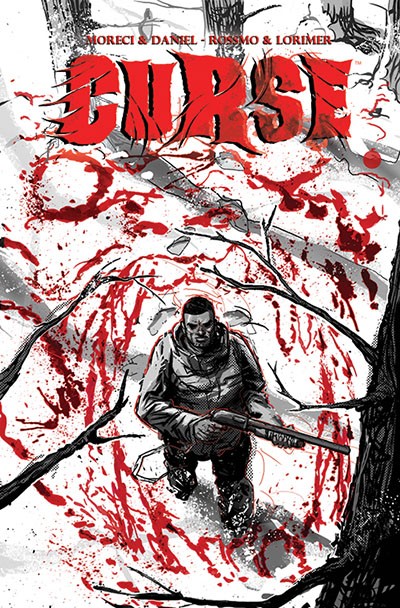 In a slightly more realistic representation, Boom! Studios presents Curse #1, by Michael Moreci and Tim Daniel, with art by Riley Rossmo and Colin Lorimer. Its protagonist is Laney Griffin, a father, former football player, and now unemployed steel plant worker whose son is dying of cancer. Laney’s sister-in-law is determined to wrest custody of the boy from Laney, who is raising him on his own after his wife’s death. She’s convinced she is better equipped to help the boy, given her job as a local Sherriff and the health benefits that come with it, but Laney is determined to keep his son. Meanwhile, several rather bloody murders have occurred in the woods outside their small northeastern town, and Laney has decided to pursue a rather radical course of action. He’ll take to the woods, shotgun in hand, catch the killer and claim the reward to pay off his debts. What Laney learns on his hunting trip is a truth far more frightening: the killer in the woods isn’t a man at all, but a werewolf! Now Laney has the monster, returned to human form, chained in his basement, and what this desperate father plans to do next is the crux of the story. As a character, Laney fits quite a few stereotypes, but the book as a whole is still more well rounded than either of the previous two we’ve looked at. The art here is both bloody and well done, as is Rossmo’s specialty, making Curse a solid horror story, with the characters’ issues serving as powerful driving factors in the story as much as the presence of a werewolf (who happens to be blond and white as a human, a point not lost on anyone).
In a slightly more realistic representation, Boom! Studios presents Curse #1, by Michael Moreci and Tim Daniel, with art by Riley Rossmo and Colin Lorimer. Its protagonist is Laney Griffin, a father, former football player, and now unemployed steel plant worker whose son is dying of cancer. Laney’s sister-in-law is determined to wrest custody of the boy from Laney, who is raising him on his own after his wife’s death. She’s convinced she is better equipped to help the boy, given her job as a local Sherriff and the health benefits that come with it, but Laney is determined to keep his son. Meanwhile, several rather bloody murders have occurred in the woods outside their small northeastern town, and Laney has decided to pursue a rather radical course of action. He’ll take to the woods, shotgun in hand, catch the killer and claim the reward to pay off his debts. What Laney learns on his hunting trip is a truth far more frightening: the killer in the woods isn’t a man at all, but a werewolf! Now Laney has the monster, returned to human form, chained in his basement, and what this desperate father plans to do next is the crux of the story. As a character, Laney fits quite a few stereotypes, but the book as a whole is still more well rounded than either of the previous two we’ve looked at. The art here is both bloody and well done, as is Rossmo’s specialty, making Curse a solid horror story, with the characters’ issues serving as powerful driving factors in the story as much as the presence of a werewolf (who happens to be blond and white as a human, a point not lost on anyone).
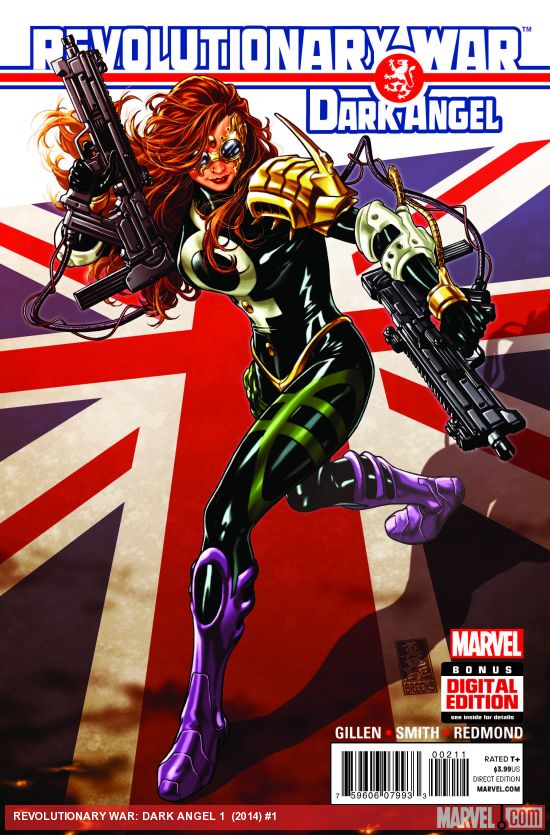 It wouldn’t be a week of new comics without a powerful female character in her own book, and Marvel delivers. Revolutionary War: Dark Angel #1 continues last week’s reboot of the Marvel UK brand with a solo series for Shevaun Haldane, known as Dark Angel. Shevaun’s father was an immortal wizard who sold his soul to Mephisto along with several other wizards, gaining immense power and eventually becoming the evil corporation Mys-Tech. His modern era daughter’s soul was sold to Mephisto as part of her father’s debt, and she was given a literal piece of the universe where her soul should be, and a set of advanced body armor to contain the immense power she now wields. Confused yet? It gets worse. Dark Angel can fly, travel between galaxies and dimensions, shoot energy from her body, and also wield conventional weapons and high tech gadgetry. She’s a giant British mash up of Captain Marvel, Iron Man and Nick Fury all in one, with a backstory that’s not clearly defined and motivations that are difficult to parse out. Is she Mephisto’s soldier, forced to do his bidding to pay her father’s debt? Or is she one of the UK’s most powerful heroines, fighting against her own evil father’s organization and aiming to save the universe? Written by Kieron Gillen, of Young Avengers fame, the story really should have more depth. Gillen was able to do so much more with a far larger cast of characters in the fan favorite YA title (which sadly ended this month), but Shevaun sees very little development. She’s a techno-mystical-cosmic-soldiering badass for certain, but to what end? This is obviously part of Marvel’s British reboot that began last week under the Revolutionary War banner, but Shevaun’s story doesn’t fit very well into that tale yet, nor does it do much to endear her to readers.
It wouldn’t be a week of new comics without a powerful female character in her own book, and Marvel delivers. Revolutionary War: Dark Angel #1 continues last week’s reboot of the Marvel UK brand with a solo series for Shevaun Haldane, known as Dark Angel. Shevaun’s father was an immortal wizard who sold his soul to Mephisto along with several other wizards, gaining immense power and eventually becoming the evil corporation Mys-Tech. His modern era daughter’s soul was sold to Mephisto as part of her father’s debt, and she was given a literal piece of the universe where her soul should be, and a set of advanced body armor to contain the immense power she now wields. Confused yet? It gets worse. Dark Angel can fly, travel between galaxies and dimensions, shoot energy from her body, and also wield conventional weapons and high tech gadgetry. She’s a giant British mash up of Captain Marvel, Iron Man and Nick Fury all in one, with a backstory that’s not clearly defined and motivations that are difficult to parse out. Is she Mephisto’s soldier, forced to do his bidding to pay her father’s debt? Or is she one of the UK’s most powerful heroines, fighting against her own evil father’s organization and aiming to save the universe? Written by Kieron Gillen, of Young Avengers fame, the story really should have more depth. Gillen was able to do so much more with a far larger cast of characters in the fan favorite YA title (which sadly ended this month), but Shevaun sees very little development. She’s a techno-mystical-cosmic-soldiering badass for certain, but to what end? This is obviously part of Marvel’s British reboot that began last week under the Revolutionary War banner, but Shevaun’s story doesn’t fit very well into that tale yet, nor does it do much to endear her to readers.
Image Expo
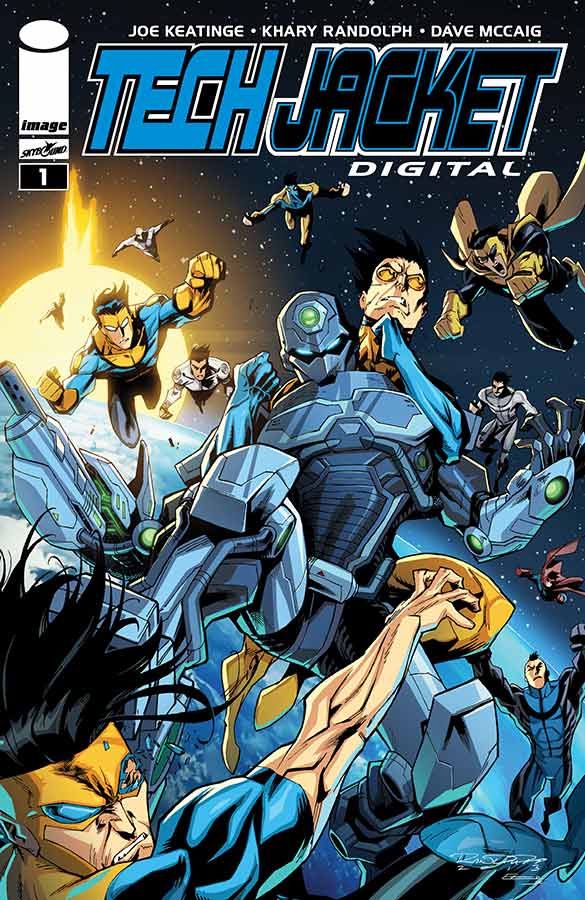 Digital comics are increasingly popular, and Image has broken ground in the medium, selling their books in a variety of DRM free formats on their site as well as cooperating with industry leaders Comixology. Last week, Image co-founder Robert Kirkman announced the creation of a purely digital new series featuring one of his first comic creations with Tech Jacket Digital #1-3. All three issues, written by Joe Keatinge with art by Khary Randolph, were made available last week on Image’s site, and are now available from Comixology. The Tech Jacket is a piece of alien technology developed by a race called the Geldarians. Geldarians are naturally soft creatures with little strength, and the advanced armor based suits allow them to survive. After a Geladarian crash on Earth reveals their existence to high school student Zach Thompson, Zach is given a Tech Jacket of his own, which adapts to his more powerful human form and makes Zach an overnight super hero. The new series features Zach’s adventures with his parents as back up and his Geldarian princess girlfriend Lin by his side, at least for a while. After a rather nasty dustup, Zach’s mother encourages him to take Lin on a nice vacation. This leads to the inevitable awkward teenage sexual experience, made even more so by the fact that neither Zach nor Lin realized they’d be physically incompatible. This touchy approach to explorations of youthful sexuality makes for a story almost everyone can appreciate. It’s a subtle metaphor for the idea that the physical expression of love is a key part of relationships, and being denied it can make things tough. Both Zach and Lin remain committed to each other after the initial bumps in the road (and interplanetary assassins) and give the book the kind of teen romance that’s popular in many YA novels these days. Lin herself is a powerhouse, not simply a princess ready to follow her man anywhere but one willing to fight for his survival. She was as fun to get to know in this book as Zach was.
Digital comics are increasingly popular, and Image has broken ground in the medium, selling their books in a variety of DRM free formats on their site as well as cooperating with industry leaders Comixology. Last week, Image co-founder Robert Kirkman announced the creation of a purely digital new series featuring one of his first comic creations with Tech Jacket Digital #1-3. All three issues, written by Joe Keatinge with art by Khary Randolph, were made available last week on Image’s site, and are now available from Comixology. The Tech Jacket is a piece of alien technology developed by a race called the Geldarians. Geldarians are naturally soft creatures with little strength, and the advanced armor based suits allow them to survive. After a Geladarian crash on Earth reveals their existence to high school student Zach Thompson, Zach is given a Tech Jacket of his own, which adapts to his more powerful human form and makes Zach an overnight super hero. The new series features Zach’s adventures with his parents as back up and his Geldarian princess girlfriend Lin by his side, at least for a while. After a rather nasty dustup, Zach’s mother encourages him to take Lin on a nice vacation. This leads to the inevitable awkward teenage sexual experience, made even more so by the fact that neither Zach nor Lin realized they’d be physically incompatible. This touchy approach to explorations of youthful sexuality makes for a story almost everyone can appreciate. It’s a subtle metaphor for the idea that the physical expression of love is a key part of relationships, and being denied it can make things tough. Both Zach and Lin remain committed to each other after the initial bumps in the road (and interplanetary assassins) and give the book the kind of teen romance that’s popular in many YA novels these days. Lin herself is a powerhouse, not simply a princess ready to follow her man anywhere but one willing to fight for his survival. She was as fun to get to know in this book as Zach was.
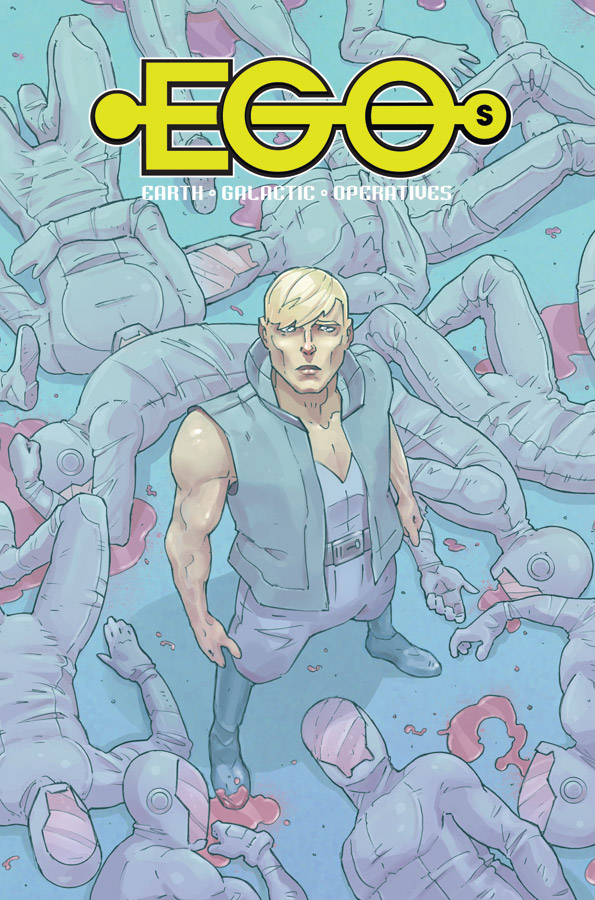 For those who like the feel the comics page in their hands, Image had several exclusive issues of previous #1’s on hand, including special issues of Sex Criminals #1, Black Science #1, and special releases of The Walking Dead. They also debuted a brand new title, EGOs #1. Written by Stuart Moore with art by Gus Storms, EGOs is the story of a future interplanetary league of heroes past their prime, facing a nasty new threat. Their leader, Deuce, is making an impassioned plea to the population that a new young team of EGOs (Earth Galactic Operatives) is needed to face an old threat, but he’s fooling almost everyone. Deuce’s super powers allow him to fool and seduce anyone with visual mirages, disguising his age as well as a dangerous secret about his all new team. Narrated by what turns out to be his weed addled college aged son, EGOs is amusing science fiction fare, looking at the lengths an aging hero would go to in order to rebuild his team and relive his glory days. Deuce’s son is bigger part of the story than he appears to be in issue #1 (he is the narrator, after all) and Deuce’s wife Miri – the EGO known as Pixel – is a formidable and grounded woman. She is the first to see through her husband’s lie and the first to aggressively call him out on it, refusing to follow him once she sees the depths he’s sunk to. We don’t want to give too much away, but Pixel’s past and Deuce’s manufactured future are dangerously intertwined, and she’s not about to put up with is scheme. Pixel is one of the more genuine characters in the book, not burdened with Deuce’s narcissism or her son’s laziness. Her maternal nature was her foremost character trait after two readings of the book, and I look forward to more of her, if nothing else.
For those who like the feel the comics page in their hands, Image had several exclusive issues of previous #1’s on hand, including special issues of Sex Criminals #1, Black Science #1, and special releases of The Walking Dead. They also debuted a brand new title, EGOs #1. Written by Stuart Moore with art by Gus Storms, EGOs is the story of a future interplanetary league of heroes past their prime, facing a nasty new threat. Their leader, Deuce, is making an impassioned plea to the population that a new young team of EGOs (Earth Galactic Operatives) is needed to face an old threat, but he’s fooling almost everyone. Deuce’s super powers allow him to fool and seduce anyone with visual mirages, disguising his age as well as a dangerous secret about his all new team. Narrated by what turns out to be his weed addled college aged son, EGOs is amusing science fiction fare, looking at the lengths an aging hero would go to in order to rebuild his team and relive his glory days. Deuce’s son is bigger part of the story than he appears to be in issue #1 (he is the narrator, after all) and Deuce’s wife Miri – the EGO known as Pixel – is a formidable and grounded woman. She is the first to see through her husband’s lie and the first to aggressively call him out on it, refusing to follow him once she sees the depths he’s sunk to. We don’t want to give too much away, but Pixel’s past and Deuce’s manufactured future are dangerously intertwined, and she’s not about to put up with is scheme. Pixel is one of the more genuine characters in the book, not burdened with Deuce’s narcissism or her son’s laziness. Her maternal nature was her foremost character trait after two readings of the book, and I look forward to more of her, if nothing else.
 Although we’ll review Image’s upcoming releases as the debut, we’d be lying if we said we weren’t excited to give you a taste of the things to come. Kelly Sue DeConnick announced her bold new title, Bitch Planet, and the series takes on the tropes of ’60’s and ’70’s “women in prison” exploitation film genre, as only DeConnick could imagine, and the cover art previewed did not disappoint. Artist Leila del Duca also took the stage with writer Joe Keatinge to announce their newest book, Shutter, the story of explorer and adventurer Kate Kristopher’s attempts to lead a “normal” life. Kate’s world is filled with monsters and mythical creatures. She just wants to be like you and me, but dark secrets from her family’s past may not allow it.
Although we’ll review Image’s upcoming releases as the debut, we’d be lying if we said we weren’t excited to give you a taste of the things to come. Kelly Sue DeConnick announced her bold new title, Bitch Planet, and the series takes on the tropes of ’60’s and ’70’s “women in prison” exploitation film genre, as only DeConnick could imagine, and the cover art previewed did not disappoint. Artist Leila del Duca also took the stage with writer Joe Keatinge to announce their newest book, Shutter, the story of explorer and adventurer Kate Kristopher’s attempts to lead a “normal” life. Kate’s world is filled with monsters and mythical creatures. She just wants to be like you and me, but dark secrets from her family’s past may not allow it.
There were dozens of other new series announced as well, all intriguing. Matt Fraction previewed new art from his still upcoming (it’s been teased at two ImageExpos now) gender swapped take on The Odyssey ODY-C, as well as announcing the return of his Cassanova series. Ed Brubaker announced an unprecedented 5 year deal with Image and his creative partner Sean Phillips to create new titles including The Fade Out. Lovers of serial killer intrigue (or just super creepy artwork) will eagerly await Joshua Williamson’s new thriller Nailbitter, about a young man whose mother forbade him from chewing his fingernails … so now he’ll eat yours! All in all, this makes us excited for what’s to come from Image (and others) 2014!

